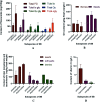The bioactive components as well as the nutritional and health effects of sea buckthorn
- PMID: 35516250
- PMCID: PMC9058667
- DOI: 10.1039/d0ra06488b
The bioactive components as well as the nutritional and health effects of sea buckthorn
Abstract
Sea buckthorn (SB), also named sea berry, Hippophae rhamnoides L. or Elaeagnus rhamnoides L., has been used in daily life for centuries with kinds of purposes ranging from a beverage with a pleasant taste and flavor, to an agent for treatment of many disorders and diseases. SB is well known more than just a fruit. So far, a unique mixture of bioactive components was elucidated in SB including flavonoids, phenolic acids, proanthocyanidins, carotenoids, fatty acids, triterpenoids, vitamins and phytosterols, which implied the great medicinal worth of this seaberry. Both in vitro and in vivo experiments, ranged from cell lines to animals as well as a few in patients and healthy volunteers, indicated that SB possessed various biological activities including anti-inflammatory and immunomodulatory effects, antioxidant properties, anti-cancer activities, hepato-protection, cardiovascular-protection, neuroprotection, radioprotection, skin protection effect as well as the protective effect against some eye and gastrointestinal sickness. Furthermore, the toxicological results revealed neither the fruits, nor the seeds of SB were toxic. The present review summarizes the unique profile of the chemical compounds, the nutritional and health effects as well as the toxicological properties of SB, which lay the foundation for practical applications of SB in treatment of human diseases.
This journal is © The Royal Society of Chemistry.
Conflict of interest statement
Authors have no conflicts of interest.
Figures







Similar articles
-
Bioactive Compounds in Sea Buckthorn and their Efficacy in Preventing and Treating Metabolic Syndrome.Foods. 2023 May 13;12(10):1985. doi: 10.3390/foods12101985. Foods. 2023. PMID: 37238803 Free PMC article. Review.
-
The beneficial health aspects of sea buckthorn (Elaeagnus rhamnoides (L.) A.Nelson) oil.J Ethnopharmacol. 2018 Mar 1;213:183-190. doi: 10.1016/j.jep.2017.11.022. Epub 2017 Nov 21. J Ethnopharmacol. 2018. PMID: 29166576 Review.
-
Phytochemistry, health benefits, and food applications of sea buckthorn (Hippophae rhamnoides L.): A comprehensive review.Front Nutr. 2022 Dec 6;9:1036295. doi: 10.3389/fnut.2022.1036295. eCollection 2022. Front Nutr. 2022. PMID: 36562043 Free PMC article. Review.
-
Bioactive compounds, health benefits and functional food products of sea buckthorn: a review.Crit Rev Food Sci Nutr. 2022;62(24):6761-6782. doi: 10.1080/10408398.2021.1905605. Epub 2021 Mar 30. Crit Rev Food Sci Nutr. 2022. PMID: 33783272 Review.
-
The Anticancer Activity of Sea Buckthorn [Elaeagnus rhamnoides (L.) A. Nelson].Front Pharmacol. 2018 Mar 15;9:232. doi: 10.3389/fphar.2018.00232. eCollection 2018. Front Pharmacol. 2018. PMID: 29593547 Free PMC article. Review.
Cited by
-
Sea buckthorn and its flavonoids isorhamnetin, quercetin, and kaempferol favorably influence bone and breast tissue health.Front Pharmacol. 2024 Oct 9;15:1462823. doi: 10.3389/fphar.2024.1462823. eCollection 2024. Front Pharmacol. 2024. PMID: 39444603 Free PMC article. Review.
-
The Use of Sea Buckthorn Processing Products in the Creation of a Functional Biologically Active Food Emulsion.Foods. 2022 Jul 26;11(15):2226. doi: 10.3390/foods11152226. Foods. 2022. PMID: 35892810 Free PMC article.
-
Bioactive Compounds in Sea Buckthorn and their Efficacy in Preventing and Treating Metabolic Syndrome.Foods. 2023 May 13;12(10):1985. doi: 10.3390/foods12101985. Foods. 2023. PMID: 37238803 Free PMC article. Review.
-
Beneficial effects of Elaeagnus rhamnoides (L.) A. Nelson and its most abundant flavonoids on the main mechanisms related to diabetic bone disease.Pharm Biol. 2025 Dec;63(1):460-489. doi: 10.1080/13880209.2025.2523392. Epub 2025 Jul 3. Pharm Biol. 2025. PMID: 40607760 Free PMC article. Review.
-
The Oxidative Stress Markers' Protective Influence of Sea Buckthorn and Grape Extracts in Atorvastatin-Treated Hyperlipidemic Rats.Nutrients. 2024 Jun 19;16(12):1954. doi: 10.3390/nu16121954. Nutrients. 2024. PMID: 38931308 Free PMC article.
References
-
- Li T. S. C. and Beveridge T. H. J., Sea Buckthorn (Hippophae rhamnoides L.): Production and Utilization, NRC Research Press, Ottawa, Ontario, 2003
-
- Ruan C. Rumpunen K. Nybom H. Crit. Rev. Biotechnol. 2013;33:126–144. - PubMed
-
- Lu S., Lu J. and Wen X., Soil and Water Conservation In China, 2019, pp. 45–49
-
- Pukhalskaia E. C. Bull. Exp. Biol. Med. 1958;45:363–366.
-
- Wang Y. Lu Y. Liu X. Gou Z. Hu J. Zhongguo Zhongyao Zazhi. 1992;17:624–626. - PubMed
Publication types
LinkOut - more resources
Full Text Sources
Other Literature Sources

